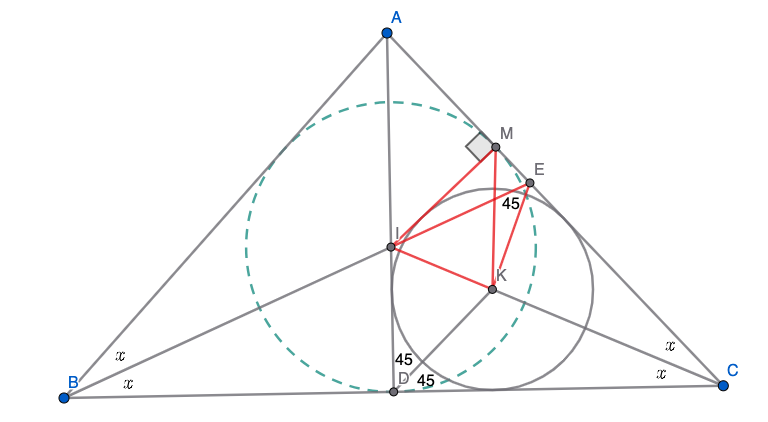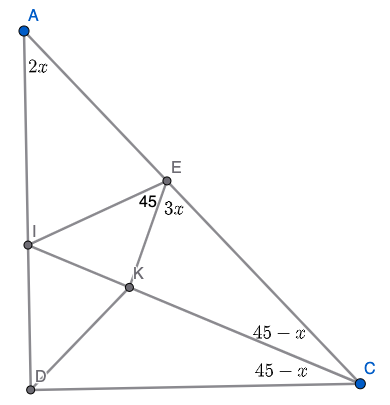Difference between revisions of "2009 IMO Problems/Problem 4"
(→Problem) |
(Added two solutions) |
||
| Line 5: | Line 5: | ||
''Authors: Jan Vonk and Peter Vandendriessche, Belgium, and Hojoo Lee, South Korea'' | ''Authors: Jan Vonk and Peter Vandendriessche, Belgium, and Hojoo Lee, South Korea'' | ||
| − | ==Solution== | + | ==Solution 1== |
| − | {{ | + | Extend <math>CK</math> to meet <math>BE</math> at <math>I</math>. Then, we can see that <math>I</math> is the incenter of <math>\triangle ABC</math>, so <math>IM=ID</math>, where <math>M</math> is the intersection of the incircle with <math>\overline{AC}</math>. |
| + | |||
| + | Since <math>CI</math> bisects <math>\angle ACB</math>, we have <math>\triangle IDC \cong \triangle IMC</math>, so <math>\angle IMK = \angle IDK = 45^\circ</math>. | ||
| + | |||
| + | From here, there are two possibilities: either <math>M</math> and <math>E</math> coincide or they don't. If <math>M</math> and <math>E</math> coincide, then <math>BM</math> is the median and the altitude from <math>B</math>, so <math>BC = AB</math>, and therefore <math>\triangle ABC</math> is equilateral, so <math>\angle BAC = 60^\circ</math>. | ||
| + | |||
| + | Otherwise, we have <math>MIKE</math> is cyclic, and <math>\angle IME = 90^\circ</math>, so <math>IE</math> is the diameter of <math>(MIKE)</math>, so <math>\angle IKE = 90^\circ</math> and <math>\angle KIE = 45^\circ</math>. Also, <math>\angle BIC = 180^\circ - \angle KIE = 135^\circ</math>, so <math>2x = 45^\circ</math>, so <math>\angle CAB = 180^\circ = 4x = 90^\circ</math>, which is the second possible value of <math>\angle CAB</math>. | ||
| + | |||
| + | [[File:2009_IMO_P4_(1).png]] | ||
| + | |||
| + | ==Solution 2== | ||
| + | |||
| + | We will be using the trig bash solution given in EGMO. | ||
| + | |||
| + | Let <math>I</math> be the incenter, and set <math>\angle DAC = 2x</math> with <math>0 < x < 45</math>. From <math>\angle AIE = \angle DIC</math>, it is easy to compute <cmath>\angle KIE = 90^\circ - 2x, \quad \angle ECI = 45^\circ - x, \quad \angle IEK = 45^\circ, \quad \angle KEC = 3x.</cmath> | ||
| + | |||
| + | Then, by LoS, we have <cmath>\dfrac{IK}{KC} = \dfrac{\sin 45^\circ \cdot \frac{EK}{\sin(90^\circ - 2x)}}{\sin(3x) \cdot \frac{EK}{\sin(45^\circ-x)}} = \frac{\sin 45^\circ \sin(45^\circ - x)}{\sin(3x) \sin(90^\circ-2x)}.</cmath> | ||
| + | |||
| + | Also, by the angle bisector theorem on <math>\triangle IDC</math>, we get <cmath>\dfrac{IK}{KC} = \dfrac{ID}{DC} = \frac{\sin(45^\circ-x)}{\sin(45^\circ+x)}.</cmath> | ||
| + | |||
| + | Equating the above two equations and cancelling <math>\sin(45^\circ-x)</math>, we get <cmath>\sin 45^\circ \sin(45^\circ+x)=\sin 3x \sin(90^\circ - 2x).</cmath> | ||
| + | |||
| + | Applying product to sum, we get <cmath>\cos(x)-\cos(90^\circ+x) = \cos(5x-90^\circ)-\cos(90^\circ+x),</cmath> | ||
| + | or simply <math>\cos x = \cos(5x-90^\circ)</math>. Then, applying difference to product, we get <cmath>0 = \cos(5x-90^\circ)-\cos x = 2 \sin(3x-45^\circ) \sin(2x-45^\circ).</cmath> | ||
| + | |||
| + | Then, we get two cases: <math>\sin(3x-45^\circ) = 0</math> or <math>\sin(2x-45^\circ) = 0</math>. Note that these hold iff the expressions inside the sines are multiples of <math>180^\circ</math>. Using the bound <math>0 < x < 45</math>, we can easily get that the only possible values are <math>x = 15^\circ</math> and <math>x = \frac{45}{2}^\circ</math>, so <math>\angle A = 60^\circ, 90^\circ</math>. | ||
| + | |||
| + | [[File:2009_IMO_P4_(2).png]] | ||
==See Also== | ==See Also== | ||
{{IMO box|year=2009|num-b=3|num-a=5}} | {{IMO box|year=2009|num-b=3|num-a=5}} | ||
Latest revision as of 02:29, 22 July 2025
Contents
Problem
Let ![]() be a triangle with
be a triangle with ![]() . The angle bisectors of
. The angle bisectors of ![]() and
and ![]() meet the sides
meet the sides ![]() and
and ![]() at
at ![]() and
and ![]() , respectively. Let
, respectively. Let ![]() be the incenter of triangle
be the incenter of triangle ![]() . Suppose that
. Suppose that ![]() . Find all possible values of
. Find all possible values of ![]() .
.
Authors: Jan Vonk and Peter Vandendriessche, Belgium, and Hojoo Lee, South Korea
Solution 1
Extend ![]() to meet
to meet ![]() at
at ![]() . Then, we can see that
. Then, we can see that ![]() is the incenter of
is the incenter of ![]() , so
, so ![]() , where
, where ![]() is the intersection of the incircle with
is the intersection of the incircle with ![]() .
.
Since ![]() bisects
bisects ![]() , we have
, we have ![]() , so
, so ![]() .
.
From here, there are two possibilities: either ![]() and
and ![]() coincide or they don't. If
coincide or they don't. If ![]() and
and ![]() coincide, then
coincide, then ![]() is the median and the altitude from
is the median and the altitude from ![]() , so
, so ![]() , and therefore
, and therefore ![]() is equilateral, so
is equilateral, so ![]() .
.
Otherwise, we have ![]() is cyclic, and
is cyclic, and ![]() , so
, so ![]() is the diameter of
is the diameter of ![]() , so
, so ![]() and
and ![]() . Also,
. Also, ![]() , so
, so ![]() , so
, so ![]() , which is the second possible value of
, which is the second possible value of ![]() .
.
Solution 2
We will be using the trig bash solution given in EGMO.
Let ![]() be the incenter, and set
be the incenter, and set ![]() with
with ![]() . From
. From ![]() , it is easy to compute
, it is easy to compute ![]()
Then, by LoS, we have ![\[\dfrac{IK}{KC} = \dfrac{\sin 45^\circ \cdot \frac{EK}{\sin(90^\circ - 2x)}}{\sin(3x) \cdot \frac{EK}{\sin(45^\circ-x)}} = \frac{\sin 45^\circ \sin(45^\circ - x)}{\sin(3x) \sin(90^\circ-2x)}.\]](http://latex.artofproblemsolving.com/a/2/1/a21b665b9edda9f1cc2e5061499315fd09c8e062.png)
Also, by the angle bisector theorem on ![]() , we get
, we get ![]()
Equating the above two equations and cancelling ![]() , we get
, we get ![]()
Applying product to sum, we get ![]() or simply
or simply ![]() . Then, applying difference to product, we get
. Then, applying difference to product, we get ![]()
Then, we get two cases: ![]() or
or ![]() . Note that these hold iff the expressions inside the sines are multiples of
. Note that these hold iff the expressions inside the sines are multiples of ![]() . Using the bound
. Using the bound ![]() , we can easily get that the only possible values are
, we can easily get that the only possible values are ![]() and
and ![]() , so
, so ![]() .
.
See Also
| 2009 IMO (Problems) • Resources | ||
| Preceded by Problem 3 |
1 • 2 • 3 • 4 • 5 • 6 | Followed by Problem 5 |
| All IMO Problems and Solutions | ||











